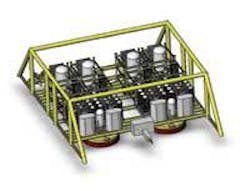Compression will be required on Ormen Lange a few years after start-up, and the solution may lie on the seabed. Technology qualification is already under way, and by the end of this year, the field partners will be looking to build and test a pilot subsea compression station.
Ormen Lange, where Norsk Hydro is development operator, is due onstream in October 2007. Gas will be produced through subsea wells at around 70 MMcm/d and exported 120 km through multiphase pipelines to a processing plant at Nyhamna on the west coast of mid-Norway. As the 400 bcm of reserves undergo depletion and reservoir pressure drops, compression will be needed to sustain the required production level.
In the plan for development and operation (PDO), compression will likely be implemented from 2016. But according to Bernt Bjerkreim, manager for the subsea compression technology project, that requirement may be advanced to 2014.
As things stand, the solution proposed in the PDO, which is based on existing technology, is an offshore compression platform. This would be a floater, as the field lies in a water depth of 850-1,100 m. Gas would have to be taken up to the platform, compressed, and then transported back to the seabed and into the two export pipelines to shore.
Testing of a pilot subsea compression station for Ormen Lange could take place in late 2008.
However, subsea compression would offer an attractive alternative, as the capex saving could be several billions of kroner, Bjerkreim says. Operating costs would also probably be lower, although an estimate is not yet available, and there would be further savings because a subsea facility would not require staffing, unlike a platform.
Forerunner projects
Work on developing subsea compression technology for Ormen Lange started in 2001, but Hydro’s involvement in related development work goes back much further. Bjerkreim cites the Troll Oseberg Gas Injection (TOGI) project, onstream in 1991, where gas was produced from the Troll field subsea, then transported unprocessed 50 km to the Oseberg field center and injected into the field to aid liquids recovery. Troll was also the scene for the world’s first - and so far only - subsea separation system. This is Hydro’s Troll Pilot, which separates water from the wellstream and pumps it down a disposal well.
Numerous offshore projects around the world employ subsea pumping, but the compression scheme envisaged for Ormen Lange would involve a quantum leap in power supply. Not only is the planned step-out 120 km, but the compressor motor would have a power rating of 12.5 MW, dwarfing the 1.8 MW pump for the Troll Pilot.
Furthermore, Ormen Lange’s proposed subsea compression station has dimensions way above those of existing subsea processing facilities. With dimensions of 35 x 48 x 12 m, the station will weigh about 2,500 tons against Troll Pilot’s 350 tons. Designed for installation in 1,000 m water depth, it will have throughput capacity of 60 MMcm/d of gas and 45,000 b/d of condensate.
The power requirement of 52 MW will be delivered from the shore as AC power through a 120 kV subsea cable. Power will be stepped down in two stages - to 22 kV at the variable-speed drive and to 6.6 kV at the compressor motor.
A program is under way to qualify the critical components. Nine studies have been contracted to vendors as follows:
• Electrical anti-surge actuator - FMC Kongsberg Subsea and IFocus (separate studies)
• High-voltage electrical connection - Deutsch and Tronic (separate studies)
• Variable speed drive - ACI Robicon and Alstom (separate studies)
• High-speed motor - Alstom Motor
• Magnetic bearing - S2M
• Compressor control - ICS Triplex.
Separate contracts have also been awarded to Vetco Gray and Kværner Oilfield Products to perform front-end engineering design (FEED) work for the power supply system. FEED contracts for the subsea compression station pilot will shortly be awarded to at least two contractors. The results of the critical component studies may be fed into this work, or alternatively some of the vendors may be asked to take their work forward into the fabrication and qualification phases, Bjerkreim says.
Availability is also a key issue. The target availability for platform compression as stipulated in the PDO is 97.5%, with an annual sales factor of 85%. The subsea system has to match that level, Bjerkreim says. Studies have been performed with DNV to demonstrate availability and these were being evaluated in February.
By the end of the year, when all the FEED work is done, the project should be in a position to pass through a key decision gate - tendering for the main contractor for the compression station pilot and the compressor vendor. The next phase involves the detailed engineering, construction, and assembly of a pilot, which could be tested at the Nyhamna terminal.
If all goes well, testing of the pilot could take place at the end of 2008. But if the current work shows that the technology is not sufficiently mature in some aspect (i.e., one of the critical components needs further development), the decision gate may have to be postponed while additional studies are carried out.
The budget for the current phase of work is NKr150 million, which is being provided by the Ormen Lange licensees. In addition to Hydro, the partners are Norske Shell, which will operate the production phase, Dong, ExxonMobil, Petoro, and Statoil. All the partners have been very supportive, and the compression project has attracted a lot of interest elsewhere, Bjerkreim says.






